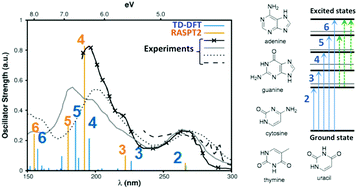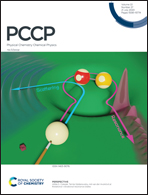First-principles characterization of the singlet excited state manifold in DNA/RNA nucleobases†
Abstract
An extensive theoretical characterization of the singlet excited state manifold of the five canonical DNA/RNA nucleobases (thymine, cytosine, uracil, adenine and guanine) in gas-phase is carried out with time-dependent density functional theory (TD-DFT) and restricted active space second-order perturbation theory (RASPT2) approaches. Both ground state and excited state absorptions are analyzed and compared between these different theoretical approaches, assessing the performance of the hybrid B3LYP and CAM-B3LYP (long-range corrected) functionals with respect to the RASPT2 reference. By comparing the TD-DFT estimates with our reference for high-lying excited states, we are able to narrow down specific energetic windows where TD-DFT may be safely employed to qualitatively reproduce the excited state absorption (ESA) signals registered in non-linear and time-resolved spectroscopy for monitoring photoinduced phenomena. Our results show a qualitative agreement between the RASPT2 reference and the B3LYP computed ESAs of pyrimidines in the near-IR/Visible spectral probing window while for purines the agreement is limited to the near-IR ESAs, with generally larger discrepancies obtained with the CAM-B3LYP functional. This outcome paves the way for appropriate application of cost-effective TD-DFT approaches to simulate linear and non-linear spectroscopies of realistic multichromophoric DNA/RNA systems with biological and nanotechnological relevance.



 Please wait while we load your content...
Please wait while we load your content...